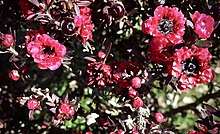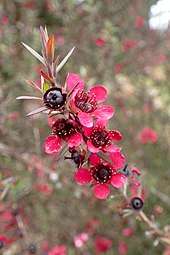Leptospermum scoparium
Leptospermum scoparium, commonly called mānuka, manuka, manuka myrtle,[1] New Zealand teatree,[1] broom tea-tree,[2] or just tea tree, is a species of flowering plant in the myrtle family Myrtaceae, native to south-east Australia and New Zealand (including the Chatham Islands).[1][3][4][5]
| Leptospermum scoparium | |
|---|---|
 | |
| Leptospermum scoparium foliage and flowers | |
| Scientific classification | |
| Kingdom: | Plantae |
| Clade: | Tracheophytes |
| Clade: | Angiosperms |
| Clade: | Eudicots |
| Clade: | Rosids |
| Order: | Myrtales |
| Family: | Myrtaceae |
| Genus: | Leptospermum |
| Species: | L. scoparium |
| Binomial name | |
| Leptospermum scoparium | |


Description
It is a prolific scrub-type tree and is often one of the first species to regenerate on cleared land. It is typically a shrub growing to 2–5 m (7–16 ft) tall, but can grow into a moderately sized tree, up to 15 m (49 ft) or so in height. It is evergreen, with dense branching and small leaves 7–20 mm (0.28–0.79 in) long and 2–6 mm (0.079–0.24 in) broad, with a short spine tip. The flowers are white, occasionally pink, 8–15 mm (0.31–0.59 in) (rarely up to 25 mm (0.98 in)) in diameter, with five petals. The wood is tough and hard.
This species is often confused with the related species kānuka (Kunzea ericoides) – the easiest way to tell the difference between the two species in the field is to feel their foliage – mānuka leaves are prickly, while kānuka leaves are soft.[6] Alternatively, the seed capsules of mānuka are large (5–7 mm (0.20–0.28 in) in diameter)[7] and often remain on the plant year round, whereas the seed capsules of kānuka are much smaller (2.2–4.6 mm (0.087–0.18 in) in diameter)[8] and are not present for much of the year.
The Latin specific epithet scoparium means “like broom”, referring to Northern Hemisphere genera such as Genista and Cytisus which it superficially resembles,[9] but to which it is only distantly related.
History and habitat
Evidence suggests that L. scoparium originated in New Zealand before the onset of the Miocene aridity, and moved as a result of long distance dispersal events from New Zealand to eastern Australia sometime during the last 20 million years. Cyclones and other wind activity are most likely responsible for transporting seeds long distances.[4] Supporters of this claim cite evidence that the genus Leptospermum arose under conditions where frequent forest fires were common (i.e. in Australia, and not temperate New Zealand), because they possess fire-adaptive traits like serotiny and storage lignotubers.[10] It has been postulated that on arrival in New Zealand, L. scoparium became established in limited edaphically suitable areas until the arrival of the Polynesian people, whose fire and forest-clearing brought about the low-nutrient-status soils for which it was preadapted in its homeland.[3] It is now more common in New Zealand than it is in Australia. It is found throughout New Zealand, but is particularly common on the drier east coasts of the North and South Islands, and in Australia in Tasmania, Victoria and New South Wales.
Ecology
Pests and diseases
The adult mānuka beetle (Pyronota festiva) and its larvae feed on L. scoparium in New Zealand.[11]
Pollinators
Various pollinators are known to visit L. scoparium, some examples include Melangyna novaezelandiae, Hylaeus, and Honeybees.[12]
Continued evolution
Leptospermum scoparium is in the process of evolutionary differentiation as a result of its isolation from fellow members of the Leptospermum genus. New studies demonstrate a loss of lignotubers among populations of Leptospermum scoparium located in relatively fire-free zones of New Zealand's South Island, while Australian and Tasmanian populations retain their lignotubers along with stronger manifestations of serotiny.[10] Australian populations of Leptospermum scoparium are shown to be chemically distinct from their New Zealand counterparts, with significantly higher levels of cinteole and monoterpines. Chemotypical variations also exist between different populations within New Zealand, leading some to suggest that L. scoparium be divided into three subspecies: those with high pinenes, high triketones, and high sesquiterpenes.[13] Recently, however, new research suggests that plant-to-plant variation far outstrips the variation seen between geographically isolated manuka sites, at least with regard to nectar chemistry.[14]
Names
Tea tree, mānuka and kāhikatoa are common names for this species.[15] "Jelly bush" is also used in Australia to describe similar honey from Leptospermum polygalifolium. Tea tree arose because Captain Cook used the leaves to make a 'tea' drink.[16]
Mānuka is a Māori word from New Zealand.[17]
Cultivation
Numerous cultivars have been developed for garden use, of which the following have gained the Royal Horticultural Society's Award of Garden Merit:-[18]
Many more cultivars are available in New Zealand but often the plant performs better in cultivation overseas. This is because in its homeland it is subject to attack by scale insects that secrete a honeydew on which grows a sooty mold that eventually debilitates the plant. Because of this, attempts have been made, with limited commercial success, to cross the showy New Zealand cultivars with mold-resistant Australian Leptospermum species.[23]
Uses

The wood was often used for tool handles. Mānuka sawdust imparts a delicious flavour when used for smoking meats and fish. It is cultivated in New Zealand for mānuka honey, produced when honeybees gather the nectar from its flowers, and for the pharmaceutical industry. It is also used for carving. An essential oil, for which many medicinal claims are made, is produced by steam distillation of its leaves. Manuka, as it is called by most New Zealanders, was used in pre-European times by Maori, and still is. A decoction of the leaves was drunk for urinary complaints and as a febrifuge (an agent for reducing fever). The steam from leaves boiled in water was inhaled for head colds. A decoction was prepared from the leaves and bark and the warm liquid was rubbed on stiff muscles and aching joints. The emollient white gum, called pai Manuka, was given to nursing babies and also used to treat scalds and burns. Chewing the bark is said to have a relaxing effect and it enhances sleep.[24]
Parakeets and parasites
Kakariki parakeets (Cyanoramphus) use the leaves and bark of mānuka and kānuka to rid themselves of parasites. Apart from ingesting the material, they also chew it, mix it with preen gland oil and apply it to their feathers.[25]
See also
- Manuka, Australian Capital Territory, which, although it is pronounced differently, was indirectly named after the New Zealand tree.
- Tea plants (Camellia sinensis) are also grown commercially in New Zealand.
References
- "Leptospermum scoparium". Germplasm Resources Information Network (GRIN). Agricultural Research Service (ARS), United States Department of Agriculture (USDA). Retrieved 15 December 2017.
- "BSBI List 2007". Botanical Society of Britain and Ireland. Archived from the original (xls) on 23 October 2014. Retrieved 17 October 2014.
- Derraik, José G. B. (2008). "New Zealand manuka (Leptospermum scoparium; Myrtaceae): a brief account of its natural history and human perceptions" (PDF). New Zealand Garden Journal. 11 (2): 4–8. Retrieved 2 May 2016.
- Thompson J., (1988) A revision of the genus Leptospermum (Myrtaceae) Telopea 3(3): 301-449
- "Leptospermum scoparium J.R.Forst. & G.Forst". Plants of the World Online. Royal Botanic Gardens, Kew. Retrieved 19 February 2020.
- J. Dawson, R. Lucas, Nature guide to the New Zealand forest. Godwit, 2000
- "Leptospermum scoparium var. scoparium | New Zealand Plant Conservation Network". m.nzpcn.org.nz. Retrieved 7 September 2018.
- "Kunzea robusta | New Zealand Plant Conservation Network". m.nzpcn.org.nz. Retrieved 7 September 2018.
- Harrison, Lorraine (2012). RHS Latin for Gardeners. United Kingdom: Mitchell Beazley. ISBN 978-1845337315.
- Bond, William J.; Dickinson, Katharine J. M.; Mark, Alan F. (19 February 2004). "What limits the spread of fire-dependent vegetation? Evidence from geographic variation of serotiny in a New Zealand shrub: Serotiny in a New Zealand shrub". Global Ecology and Biogeography. 13 (2): 115–127. doi:10.1111/j.1466-882X.2004.00070.x.
- "Shrublands guide" (PDF). Auckland Council. Auckland Council. Retrieved 2 May 2016.
- Primack, Richard B. (1 July 1983). "Insect pollination in the New Zealand mountain flora". New Zealand Journal of Botany. 21 (3): 317–333. doi:10.1080/0028825X.1983.10428561. ISSN 0028-825X.
- Perry, Nigel B.; Brennan, Nerida J.; Van Klink, John W.; Harris, Warwick; Douglas, Malcolm H.; McGimpsey, Jennifer A.; Smallfield, Bruce M.; Anderson, Rosemary E. (April 1997). "Essential oils from New Zealand manuka and kanuka: Chemotaxonomy of Leptospermum". Phytochemistry. 44 (8): 1485–1494. doi:10.1016/s0031-9422(96)00743-1. ISSN 0031-9422.
- Noe, Stevie; Manley-Harris, Merilyn; Clearwater, Michael J. (2 October 2019). "Floral nectar of wild mānuka (Leptospermum scoparium) varies more among plants than among sites". New Zealand Journal of Crop and Horticultural Science. 47 (4): 282–296. doi:10.1080/01140671.2019.1670681. ISSN 0114-0671.
- "Mānuka/kāhikatoa and kānuka". New Zealand Government - Te Wānanga o Aotearoa Department of the Environment. Retrieved 7 July 2017.
- J. T. Salmon, The Native Trees of New Zealand, Reed, 1973. ISBN 0-589-01340-8
- "mānuka - Māori Dictionary". Maori Dictionary. Retrieved 12 January 2018.
- "AGM Plants - Ornamental" (PDF). Royal Horticultural Society. July 2017. p. 59. Retrieved 21 March 2018.
- "RHS Plant Selector - Leptospermum scoparium 'Kiwi'". Archived from the original on 6 May 2013. Retrieved 21 May 2013.
- "RHS Plant Selector - Leptospermum scoparium 'Nichollsii Nanum'". Archived from the original on 23 April 2013. Retrieved 21 May 2013.
- "RHS Plant Selector - Leptospermum scoparium 'Red Damask'". Archived from the original on 23 April 2013. Retrieved 21 May 2013.
- "RHS Plant Selector - Leptospermum scoparium 'Silver Sheen'". Archived from the original on 23 April 2013. Retrieved 21 May 2013.
- "1999 RNZIH Conference Report". Retrieved 5 December 2013.
- http://www.manukaoil.com/manuka_oil_uses.htm
- T. Greene, Antiparasitic behaviour in New Zealand parakeets (Cyanoramphus species). Notornis 36 (4) (1989): 322–323. PDF
External links
- New Zealand Plant Conservation Network - Leptospermum scoparium var. scoparium
| Wikimedia Commons has media related to Leptospermum scoparium. |